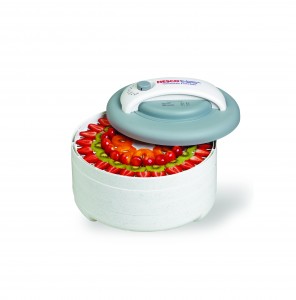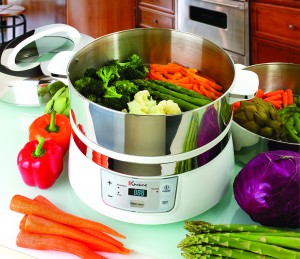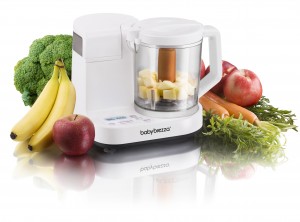Small Appliances for Healthy Eaters
The next edition of the U.S. Department of Agriculture’s Dietary Guidelines for Americans is due to be issued this year, but the broad outline for those guidelines has already been released in the form of the Scientific Report of the 2015 Dietary Guidelines Advisory Committee. Among the highlights of the report: suggestions for more urging for Americans to modify their diets and get more exercise; more pressure on the food industry to reformulate food products in a healthier direction; and a tax on sugar-sweetened beverages, snack foods and desserts that could be used to fund obesity prevention programs.
The U.S. government uses the Dietary Guidelines as the basis of its food assistance programs, nutrition education efforts and decisions about national health objectives, including the menu planning for the National School Lunch Program. Dietary Guidelines for Americans were first released in 1980 and have been updated every five years since. The point of this report from the advisory committee is to inform the next edition of the Dietary Guidelines.
Today, about half of all American adults have one or more preventable chronic diseases related to their diets and about two thirds of American adults are overweight or obese. These two conditions have been highly prevalent for more than two decades, and few, if any, improvements in consumers’ food choices have been seen in recent decades, the report says, adding that a food environment epitomized by an abundance of highly-processed, convenient, lower-cost, energy-dense, nutrient-poor foods makes it particularly challenging to persuade Americans to change their ways.
In order to comply with the Dietary Guidelines, Americans may have to reduce screen time, eat at fast food restaurants less often, eat at home with their families more often and monitor their own diet and body weight. For this approach to work, it would also be essential for Americans, particularly low-income Americans, to have access to healthy and affordable food choices that respect their cultural preferences.
The housewares industry is already responding to the increased attention to healthy nutrition that the new dietary guidelines will prompt with small appliances that can help home cooks approach their healthy eating goals with convenience and added control. Food dehydrators are an example.
 “The reason people might want to use a dehydrator is because that way they know what’s in their food,” says Darlene Schmitz, Vice President of Sales & Marketing for The Metal Ware Corporation, manufacturers of Nesco dehydrators. “When you dehydrate, you don’t add anything to the food, generally.… The natural sugars that are in the food actually concentrate as the food shrinks because the food gets smaller, so the food actually tastes sweeter than it does in the raw state. That way, you know where the food came from. You bought it at the store, you bought it at a farmers market, you grew it yourself – and you know exactly what’s in it.”
“The reason people might want to use a dehydrator is because that way they know what’s in their food,” says Darlene Schmitz, Vice President of Sales & Marketing for The Metal Ware Corporation, manufacturers of Nesco dehydrators. “When you dehydrate, you don’t add anything to the food, generally.… The natural sugars that are in the food actually concentrate as the food shrinks because the food gets smaller, so the food actually tastes sweeter than it does in the raw state. That way, you know where the food came from. You bought it at the store, you bought it at a farmers market, you grew it yourself – and you know exactly what’s in it.”
Schmitz says Nesco has been using the dehydrators at shows to make kale chips, with just a little olive oil and lemon pepper added, that are surprisingly a big hit with kids. Another favorite is sun-dried tomatoes, with a touch of Italian seasonings and olive oil, that also come out like a chip. Many customers use the appliance to make jerky, and Nesco also has a jerk gun for this use. A tray called a fruit roll sheet can be used for liquids or semi-liquids to make a fruit roll-up type treat. Users can even dehydrate soup, spaghetti sauce, or chili and then reconstitute it later. Dog treats are another possibility.
Nesco has been making dehydrators for over 40 years now and has 11 different models to choose from, ranging in price from $39 to $179. Schmitz says any of the models with an adjustable thermostat would make a nice entry level choice are any of the models that have an adjustable thermostat because this allows customers to figure out the setting they like best for produce versus meats, whereas other basic models have a set temperature. The Snackmaster[R] Encore Food Dehydrator (FD-61) comes with four trays, including a fruit roll sheet, and is adjustable to up to 12 trays that are purchased separately. It has an adjustable thermostat that ranges from 95 to 160 degrees Fahrenheit, 500 watts of drying power, and a suggested retail price of $69.99.
 For consumers who are concerned about the amount of fat in their diet, Euro Cuisine’s Stainless Steel 2-Tier Electric Steamer allows home cooks to steam up a complete meal in the electric steamer’s two included 8.5-quart baskets. Vegetables, seafood and poultry can all be made at the same time with the different flavors on each tray. An easy-to-read LCD display features a built-in 90-minute timer, and the unit also features a built-in warming function. The Electric Steamer has a suggested retail price of $159.99.
For consumers who are concerned about the amount of fat in their diet, Euro Cuisine’s Stainless Steel 2-Tier Electric Steamer allows home cooks to steam up a complete meal in the electric steamer’s two included 8.5-quart baskets. Vegetables, seafood and poultry can all be made at the same time with the different flavors on each tray. An easy-to-read LCD display features a built-in 90-minute timer, and the unit also features a built-in warming function. The Electric Steamer has a suggested retail price of $159.99.
The new Zojirushi Fish Roaster cooks fish without the funk, which will appeal to those who are looking for ways to incorporate more unsaturated fats and Omega 3 fatty acids into their diets. The countertop unit has a platinum catalytic filter to eliminate up to 90 percent of smoke and odor components. A stainless steel roasting rack directs excess oils and fats away from food. The Fish Roaster also features an adjustable timer up to 30 minutes, a flip-open lid for easy operation and a food server for easy removal of foods. It has a suggested retail price of $200.
 Health conscious consumers can also ensure their baby’s food is healthy too with Baby Brezza’s new One Step Baby Food Maker Glass that launches this month. This latest version of the One Step Baby Food Maker will be the only model on the market with a large 4-cup capacity glass bowl. Using a patented dual steam and blend functionality, users can make thier own baby food with the push of a single button. Baby Brezza will cook and blend the food at the same time, or users can choose from the steam only or blend only settings. The one bowl design eliminates the need to transfer hot foods into a separate blender, while a removable water tank simplifies filling and cleaning. The One Step Baby Food Maker Glass has a suggested retail price of $159.99.
Health conscious consumers can also ensure their baby’s food is healthy too with Baby Brezza’s new One Step Baby Food Maker Glass that launches this month. This latest version of the One Step Baby Food Maker will be the only model on the market with a large 4-cup capacity glass bowl. Using a patented dual steam and blend functionality, users can make thier own baby food with the push of a single button. Baby Brezza will cook and blend the food at the same time, or users can choose from the steam only or blend only settings. The one bowl design eliminates the need to transfer hot foods into a separate blender, while a removable water tank simplifies filling and cleaning. The One Step Baby Food Maker Glass has a suggested retail price of $159.99.

You must be logged in to post a comment.